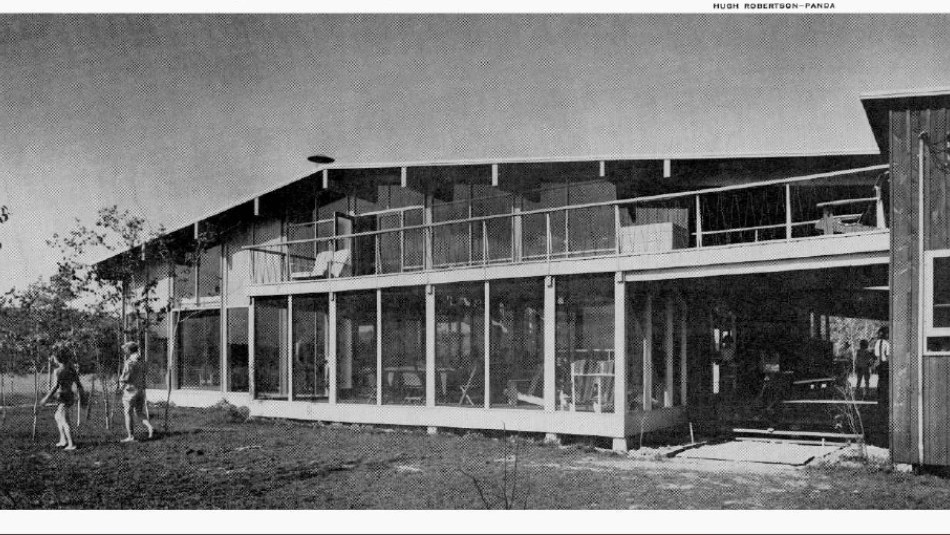
Mine Mill, having grown out of the Western Federation of Miners, maintained that union’s involvement in community life, and offered cultural and recreational activities for its members and the larger community. In 1949, Mine Mill purchased 166 acres of farm land along Highway 69 South, turning the section east of the highway into a summer camp for Mine Mill children – as well as for youngsters from families of other unions – and picnic and beach grounds available to community groups.
The children’s day camp began in 1951, while the residential program began in 1952. By 1954 Mine Mill Camp boasted a beautiful main lodge which won an award for architectural design. The lodge served as the mess hall and gathering place for the children attending the camp. It also had an extensive library on the upper floor, as well as six bunkhouses – three for boys and three for girls – and male and female bathing facilities. A small candy and craftshop at the site allowed young campers to spend a predetermined amount each week. In the off-season, the lodge was used for steward’s school.
Recreational director Weir Reid handled the administration of the camp. The season began each June with a two week training school for counselors. The registration fee for members’ children was subsidized by the local. The union offered working-class children the opportunity to attend summer camp, and offered parents a vacation as well.
Mine Mill Camp provided Sudbury’s first organized beach facility, complete with a waterfront director, lifeguards and counselors to supervise beachfront activities, plus a nurse to watch over the health of campers. The teen counselors were trained in leadership programs and were generally members’ children who had outgrown attending as campers. The children who attended the summer camp took part in arts and crafts, pioneer days, nature studies, and sports such as swimming and canoeing.
The day began with an early morning “sunshine swim” followed by breakfast in the main hall. After supper was considered free time, when the children were encouraged to socialize and read. The day closed with a camp fire and singsong and an early lights out. Grace was always said by Weir Reid or his wife Ruth, and Sunday church services organized. Reid’s cultural leadership was very successful at the summer camp and in the community. However, those supporting the Steelworkers attacked Reid for indoctrinating children and others with left-wing ideas. Using Cold War rhetoric, they assassinated his character and hindered his work.
Unfortunately, Mine Mill Camp was never quite the same after the Reform slate of Mine Mill took control of the camp in 1960, and after Mine Mill was succeeded by the USWA after the certification vote. The grounds and buildings deteriorated, programs declined, and the spirit of Mine Mill Camp was lost. One revealing anecdote about the Reformer’s takeover of the camp involves a number of bear cubs rescued from fires in Skead and taken in at Mine Mill Camp in 1953. Once the Reformers took possession of the camp in the early 1960’s, the bears were let go since the Reformers argued the animals were symbols of Russian Communism.
Although the camp was reopened by Mine Mill during 1965 and 1966 under direction of the Reid’s, a number of lawsuits against the Steelworkers were necessary for Mine Mill to maintain ownership of the camp. This was achieved in 1967. But by then, the union due to the loss of membership and the depletion of financial resources after the 1958 strike – couldn’t afford the necessary improvements to Mine Mill Camp. After 1966, summer sessions for children were no longer offered, and the once glorious lodge was torn down in the mid 1980’s, and most other buildings were also demolished. The only remaining structures are the office at the entrance, the crafts and recreation building, and the original farm house, which was occupied in the camp’s peak years by a groundskeeper and later by out-of-town union personnel.
In 1969, Mine Mill Camp was converted into a tent and trailer park for the general public. Due to decreasing membership, the camp once again had to close in 1999.
In 2009, the President and Executive Board took the necessary steps to move out of the their current union hall located on Regent Street and decided to build a new building at the back of the campgrounds. It was at that time that their vision wasn’t just to re-locate their union office, but to also get the Mine Mill Camp ground back up and running.
Their vision has proved tremendously successful today with the camp grounds now maintaining approximately 95 seasonal campers and has worked very hard to bring the campgrounds back to a beautiful recreational get-away to the public.

